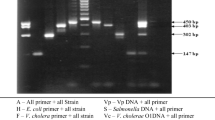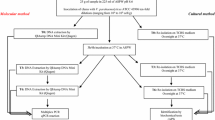Abstract
Histamine fish poisoning becomes highly concern not only in public health but also economic aspect. Histamine is produced from histidine in fish muscles by bacterial decarboxylase enzyme. Several techniques have been developed to determine the level of histamine in fish and their products but the effective method for detecting histamine producing bacteria is still required. This study was attempted to detect histamine producing bacteria by newly developed PCR condition. Histamine producing bacteria were isolated from scombroid fish and determined the ability to produce histamine of isolated bacteria by biochemical and TLC assays. PCR method was developed to target the histidine decarboxylase gene (hdc). The result showed that fifteen histamine producing bacterial isolates and three standard strains produced an amplicon at the expected size of 571 bp after amplified by PCR using Hdc_2F/2R primers. Fifteen isolates of histamine producing bacteria were classified as M. morganii, E. aerogenes, and A. baumannii. The lowest detection levels of M. morganii and E. aerogenes were 102 and 105 Cfu/mL in culture media and 103 and 106 Cfu/mL in fish homogenates, respectively. The limit of detection by this method was clearly shown to be sensitive because the primers could detect the presence of M. morganii and E. aerogenes before the histamine level reached the regulation level at 50 ppm. Therefore, this PCR method exhibited the potential efficiency for detecting the hdc gene from histamine producing bacteria and could be used to prevent the proliferation of histamine producing bacteria in fish and fish products.


Similar content being viewed by others
References
Ababouch L, Afilall ME, Rhafiri S, Busta FF (1991) Identification of histamine producing bacteria isolated from sardine (Sadina pilchardus) stored in ice and at ambient temperature (25 °C). Food Microbiol 8:127–136
Björnsdóttir K, Bolton GE, McClellan-Green PD, Jaykus LA, Green DP (2009) Detection of Gram-negative histamine-producing bacteria in fish: a comparative study. J Food Prot 72(9):1987–1991
Björnsdóttir-Butler K, Bolton GE, Jaykus LA, McClellan PD, Green DP (2010) Development of molecular-based methods for determination of high histamine producing bacteria in fish. Int J Food Microbiol 139:161–167
Björnsdóttir-Butler K, Jones JL, Benner R, Burkhardt K (2011) Development of a real-time PCR assay with an internal amplification control for detection of Gram-negative histamine-producing bacteria in fish. Food Microbiol 28(3):356–363
Bover-Cid S, Holzapfel WH (1999) Improved screening procedure for biogenic amine production by lactic acid bacteria. Int J Food Microbiol 53:33–41
Chen HC, Kung HF, Chen WC, Lin WF, Hwang DF, Lee YC, Tsai YH (2008) Determination of histamine and histamine forming bacteria in tuna dumpling implicated in a food-borne poisoning. Food Chem 106:612–618
Chen HC, Huang YR, Hsu HH, Lin CS, Chen WC, Lin CM, Tsai YH (2010) Determination of histamine and biogenic amines in fish cubes (Tetrapturus angustirostris) implicated in a food-borne poisoning. Food Control 21:13–18
De las Rivas B, Marcobal Á, Muñoz R (2005) Improved multiplex-PCR method for the simultaneous detection of food bacteria producing biogenic amines. FEM Microbiol Lett 244(2):367–372
Ferrario C, Ricci G, Borgo F, Fortina MG (2012) Species-specific DNA probe and development of a quantitative PCR assay for the detection of Morganella morganii. Lett Appl Microbiol 54(4):292–298
Hungerford JM (2010) Scombroid poisoning: a review. Toxicon 56:231–243
Huss HH (1997) Control of indigenous pathogenic bacteria in seafood. Food Control 8(2):91–98
Kim SH, Price RJ, Morrissey MT, Field KG, Wei CI, An H (2002) Histamine production by Morganella morganii in mackerel, albacore, mahi-mahi, and salmon at various storage temperature. J Food Sci 67(4):1522–1528
Kim SH, An H, Field KG, Wei CL, Velazquez JB, Ben-Gigirey BA, Morrissey MT, Price RJ, Pitta TP (2003a) Detection of Morganella morganii, a prolific histamine former, by the polymerase chain reaction assay with 16S rDNA-targeted primers. J Food Prot 66(8):1385–1392
Kim SH, An H, Wei CI, Visessanguan W, Benjakul S, Morrissey MT, Su YC, Pitta TP (2003b) Molecular detection of a histamine former, Morganella morganii, in albacore, mackerel, sardine, and processing plant. Food Chem Toxicol 68(2):453–457
Kim MK, Mah JH, Hwang HJ (2009) Biogenic amine formation and bacterial contribution in fish, squid and shellfish. Food Chem 116:87–95
Klausen NK, Huss HH (1987) Growth and histamine production by Morganella morganii under various temperature conditions. Int J Food Microbiol 5:147–156
Kung HF, Lee TM, Lin CS, Hong TY, Tsai YH (2012) Polymerase chain reaction for the detection of histamine producing bacteria isolated from Taiwanese foods. J Food Drug Anal 20(1):74–82
Lehane L, Olley J (2000) Histamine fish poisoning revisited. Int J Food Microbiol 58:1–37
Lipp EK, Rose JB (1997) The role of seafood in foodborne diseases in the United States of America. Rev Sci Tech Off Int Epiz 16(2):620–640
Lund EK (2013) Health benefits of seafood; is it just the fatty acids? Food Chem 140:413–420
McLauchlin J, Little CL, Grant KA, Mithani V (2005) Scombrotoxin fish poisoning. J Public Health 28(1):61–62
Niven-JR CF, Jeffrey MB, Corlett-JR DA (1981) Differential plating medium for quantitative detection of histamine producing bacteria. Appl Environ Microbiol 41(1):321–322
Puwastien P, Judprasong K, Kettwan E, Vasanachitt K, Nakngamanong Y, Bhattacharjee L (1999) Proximate composition of raw and cooked Thai freshwater and marine fish. J Food Compos Anal 12:9–16
Rawles DD, Flick GJ, Martin RE (1996) Biogenic amines in fish and shellfish. Adv Food Nutr Res 39:329–365
Saitou N, Nei M (1987) The neighbor-joining method: a new method for reconstructing phylogenetic trees. Mol Biol Evol 39:783–791
Santos MH (1996) Biogenics amines: their importance in foods. Int J Food Microbiol 29:213–231
Takahashi H, Kimura B, Yoshikawa M, Fujii T (2003) Cloning and sequencing of the histidine decarboxylase genes of Gram-negative, histamine-producing bacteria and their application in detection and identification of these organism in fish. Appl Environ Microbiol 69(5):2568–2579
Tamura K, Neu M, Kumar S (2004) Prospects for inferring very large phylogenies by using the neighbor-joining method. Proc Natl Acad Sci U S A 101:11030–11035
Tamura K, Stecher G, Peterson D, Filipski A, Kumar S (2013) MEGA6: molecular genetics analysis version 6.0. Mol Biol Evol 30:2725–2729
Tao Z, Sato M, Zhang H, Yamaguchi T, Nakano T (2011) A survey of histamine content in seafood sold in markets of nine countries. Food Control 22:430–432
Taylor SL (1986) Histamine food poisoning: toxicology and clinical aspects. Crit Rev Toxicol 17(2):91–128
Taylor SL, Guthertz LS, Leatherwood M, Tillman F, Lieber ER (1978) Histamine production by food-borne bacterial species. J Food Saf 1:173–187
Taylor SL, Stratton JE, Nordlee JA (1989) Histamine poisoning (scombroid fish poisoning): an allergy like intoxication. Clin Toxicol 27(4–5):225–240
Valls JE, Bello RA, Kodaira MS (2002) Semiquantitative analysis by thin-layer chromatography (TLC) of biogenic amines in dried, salted and canned fish products. J Food Qual 25:165–176
Acknowledgments
This study was supported by the Coordinating Center for Research and Development to increase the value of Plants Indigenous to Thailand, Mahidol University, and the Thailand Research Fund. The authors wish to thank the staff at the Department of Microbiology, Mahidol University, Thailand.
Author information
Authors and Affiliations
Corresponding author
Rights and permissions
About this article
Cite this article
Wongsariya, K., Bunyapraphatsara, N., Yasawong, M. et al. Development of molecular approach based on PCR assay for detection of histamine producing bacteria. J Food Sci Technol 53, 640–648 (2016). https://doi.org/10.1007/s13197-015-1982-1
Revised:
Accepted:
Published:
Issue Date:
DOI: https://doi.org/10.1007/s13197-015-1982-1




